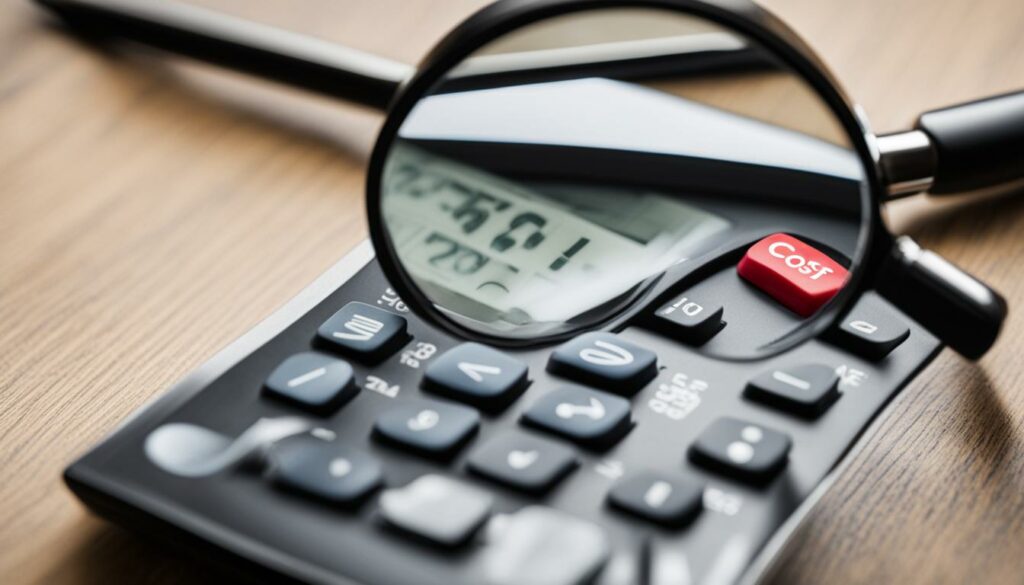Welcome to the world of Cost Per Acquisition (CPA) in Ecommerce. As a vital metric in digital marketing, CPA measures the cost incurred to acquire one paying customer on a campaign or channel level. Understanding CPA is crucial for businesses looking to gauge marketing success and optimize their strategies.
CPA finds application in various paid marketing mediums, including PPC, affiliate marketing, display advertising, social media, and content marketing. It can also be leveraged in ecommerce SEO and email marketing campaigns, making it a versatile metric for business growth.
When defining a quality CPA, it is important to consider factors such as the business stage, budget, advertising medium, and how “acquisition” is defined. Tracking CPA can be achieved through various methods like UTM parameters, PPC campaign data, custom links, CRM systems, and lead forms.
Key Takeaways:
- Cost Per Acquisition (CPA) measures the cost of acquiring one paying customer on a campaign or channel level.
- CPA is used in various paid marketing mediums, including PPC, affiliate marketing, display advertising, social media, and content marketing.
- Tracking CPA can be done through methods like UTM parameters, PPC campaign data, custom links, CRM systems, and lead forms.
- Defining a quality CPA depends on factors like business stage, budget, advertising medium, and how “acquisition” is defined.
- Understanding CPA is essential for businesses to make informed decisions about marketing strategies and budget allocation.
How to Calculate Cost Per Acquisition
To effectively measure the success of marketing campaigns, it is crucial to calculate the Cost Per Acquisition (CPA). This metric allows businesses to determine the average cost of acquiring a customer through specific campaigns. To calculate the CPA, follow this simple formula:
CPA = Variable Marketing Cost ÷ Number of Conversions
First, determine the variable marketing cost incurred during a specific time period. This includes expenses related to advertising, promotions, and other marketing activities. Next, count the number of conversions, which represent the new customers who have made a purchase within that same time period. Divide the variable marketing cost by the number of conversions, and you’ll have your CPA.
For instance, let’s consider a campaign that incurred a variable marketing cost of $22,000 over a month and resulted in 1800 new customers:
CPA = $22,000 ÷ 1800
CPA = $12.22
In this example, the Cost Per Acquisition for the campaign would be $12.22.
Example Calculation
| Variable Marketing Cost | Number of Conversions | CPA |
|---|---|---|
| $22,000 | 1,800 | $12.22 |
By calculating the CPA, businesses gain valuable insights into the effectiveness of their marketing efforts. This information allows them to make data-driven decisions about budget allocation and optimize their overall marketing strategies. Additionally, tracking CPA enables businesses to monitor campaign performance and identify areas for improvement.

Importance of Cost Per Acquisition in Ecommerce
Cost Per Acquisition is a critical metric for ecommerce businesses as it directly measures the revenue impact of marketing campaigns. By understanding the cost per acquisition, businesses can make informed decisions about their marketing strategies and budget allocation. Let’s explore why Cost Per Acquisition is so important in the world of ecommerce.
The Revenue Impact
Cost Per Acquisition provides businesses with valuable insights into the revenue impact of their marketing efforts. By calculating the cost to acquire each customer, ecommerce businesses can assess the effectiveness of their campaigns in generating sales. This metric allows them to identify the most profitable marketing channels and allocate resources accordingly, maximizing their return on investment.
Insights into Marketing Success
While conversion rates are an important indicator of marketing success, Cost Per Acquisition offers a broader perspective. It helps businesses assess the overall success of their campaigns from a business standpoint. By examining the cost per acquisition, ecommerce businesses can evaluate the efficiency of their marketing strategies and identify areas for improvement.
Factors for Determining an Acceptable CPA
When it comes to determining an acceptable Cost Per Acquisition, ecommerce businesses consider several factors. One crucial consideration is the average order value (AOV), which represents the average amount customers spend per purchase. Businesses with higher AOV may be willing to invest more in customer acquisition. Another factor is customer lifetime value (CLV), the predicted value of a customer throughout their relationship with the business. By assessing CLV, businesses can determine how much they can spend on acquiring new customers while still achieving profitability.
Optimizing Marketing Strategies
Understanding the cost per acquisition enables ecommerce businesses to optimize their marketing strategies. By comparing the performance of different campaigns and channels, businesses can identify the most cost-effective approaches. This allows them to allocate their budget towards the strategies that generate the best results, ultimately improving their overall marketing efficiency.
Example:
Let’s look at an example to illustrate the significance of Cost Per Acquisition. Suppose an ecommerce business runs two marketing campaigns. Campaign A has a Cost Per Acquisition of $15, while Campaign B has a Cost Per Acquisition of $25. Despite Campaign B having a higher acquisition cost, it generates customers with a significantly higher average order value. By analyzing the cost per acquisition alongside other factors such as AOV and CLV, the business can conclude that Campaign B delivers higher long-term profitability, even with a higher acquisition cost.
To sum up, Cost Per Acquisition plays a vital role in the success of ecommerce businesses. By understanding the revenue impact, assessing marketing success, considering factors such as AOV and CLV, and optimizing marketing strategies, businesses can effectively manage and improve their Cost Per Acquisition, leading to greater profitability and growth in the competitive ecommerce industry.
Strategies to Improve Cost Per Acquisition
Improving Cost Per Acquisition (CPA) is crucial for optimizing marketing campaigns and maximizing return on investment. By implementing effective strategies, businesses can enhance their conversion rates and minimize the cost of acquiring customers. Here are several proven tactics to improve CPA:
1. Landing Page Optimization
A well-optimized landing page is essential for driving conversions and reducing CPA. By ensuring that your landing pages are clear, visually appealing, and aligned with your target audience’s needs, you can significantly improve the chances of conversion.
2. Identifying Purchase Intention
Understanding the purchase intention of your target audience is key to optimizing your marketing efforts. Conducting surveys or implementing advanced analytics tools can help you gather insights on customer preferences, enabling you to tailor your campaigns and messaging accordingly.
3. Check-out Process Optimization
Streamlining the check-out process is crucial to reducing cart abandonment rates and improving CPA. Simplify the process by minimizing the number of steps, optimizing page load speed, and offering guest check-out options, making it easier and faster for customers to complete their purchase.
4. Utilizing Retargeting Techniques
Retargeting allows you to reconnect with potential customers who have previously shown interest in your products or services. By strategically displaying personalized ads to these individuals, you can nurture their intent and encourage them to convert, ultimately improving your CPA.
5. Personalization
Personalizing your ads and marketing campaigns can significantly enhance their effectiveness. By leveraging data and segmentation techniques, you can tailor your messaging to resonate with individual users, increasing engagement and conversion rates while reducing CPA.
6. Improving Google Quality Score
Google Quality Score directly impacts the cost and positioning of your ads in search engine result pages. By optimizing ad copy, relevancy, landing pages, and targeting, you can increase your Quality Score, resulting in lower cost-per-click (CPC) and, ultimately, decreased CPA.
Implementing these strategies can help businesses effectively optimize their Cost Per Acquisition. By continuously monitoring and analyzing the performance of these tactics, it is possible to refine and improve marketing efforts, achieving optimal results in customer acquisition and cost efficiency.

Customer Behavior and Cost Per Acquisition
Understanding customer behavior is essential in determining the Cost Per Acquisition (CPA) for businesses. By analyzing customer actions and preferences, businesses can optimize their marketing strategies, increase conversions, and reduce CPA. One key aspect to consider is the customer lifetime value (CLV), which helps determine the long-term profitability of acquiring a customer.
Conversion rate optimization (CRO) is another critical factor in managing CPA. By analyzing and improving the various elements of the customer’s journey, businesses can enhance the conversion process and increase the efficiency of their marketing efforts. This includes optimizing landing pages, streamlining the checkout process, and utilizing persuasive call-to-actions.
Exit-intent overlays are effective tools for re-engaging visitors and addressing objections. These overlays appear when a user intends to leave a website, offering incentives, or capturing contact information through opt-ins. They provide an opportunity to persuade visitors to reconsider their decision, potentially leading to conversions and reducing CPA.
The Impact of Customer Behavior on CPA
Customer behavior directly influences CPA as it dictates the effectiveness of marketing campaigns. By understanding the factors that influence customer decision-making, such as their preferences, needs, and pain points, businesses can tailor their strategies to resonate with their target audience. This personalized approach increases the likelihood of conversions and reduces CPA.
“By studying and analyzing customer behavior, businesses can make informed decisions to optimize their marketing strategies and improve return on investment.”
For example, suppose an ecommerce business observes that customers with a higher CLV tend to convert at a higher rate. In that case, they may allocate more resources and budget towards acquiring similar customers, who are likely to generate a higher return on investment.
Ultimately, analyzing customer behavior allows businesses to make data-driven decisions to reduce CPA. By understanding their customers’ preferences, addressing their objections, and optimizing the conversion process, businesses can maximize their marketing efforts and improve their bottom line.
Next, we’ll discuss some of the challenges and considerations businesses face when measuring and managing Cost Per Acquisition.

Challenges and Considerations for Cost Per Acquisition
When it comes to Cost Per Acquisition (CPA), businesses face various challenges and have important considerations to take into account. One of the key considerations is analyzing the marketing budget and operating costs. By carefully assessing these factors, businesses can determine the target CPA that they can afford. This helps in setting realistic goals and ensures that the marketing efforts are aligned with the available resources.
Additionally, factors such as the business stage, industry, and customer behavior can significantly impact the desired CPA. Each business operates in a unique environment, and understanding these contextual factors is crucial in estimating a feasible and effective CPA for acquiring customers.
Continuous monitoring and analysis of CPA are essential for success in marketing campaigns. By closely monitoring the performance of CPA, businesses can identify trends, evaluate the effectiveness of their strategies, and make necessary adjustments to optimize results. Adapting to changes and implementing data-driven insights helps in overcoming challenges and improving the cost efficiency of customer acquisition.
Managing and improving Cost Per Acquisition requires businesses to overcome various hurdles and consider a range of factors. By carefully analyzing marketing budgets, operating costs, industry dynamics, and customer behavior, businesses can make informed decisions and develop strategies that align with their objectives. By overcoming challenges and staying ahead of the competition, businesses can successfully optimize their cost per acquisition and drive sustainable growth.
FAQ
What is Cost Per Acquisition (CPA) in Ecommerce?
Cost Per Acquisition (CPA) is a marketing metric that measures the aggregate cost to acquire one paying customer on a campaign or channel level. It is used in various paid marketing mediums, including PPC, affiliate marketing, display advertising, social media, and content marketing.
How to Calculate Cost Per Acquisition?
To calculate Cost Per Acquisition, divide the variable marketing cost over a certain time period by the number of new customers who have placed an order within that time period. This formula helps determine the average cost of acquiring a customer through a specific campaign.
What is the Importance of Cost Per Acquisition in Ecommerce?
Cost Per Acquisition is an important metric for ecommerce businesses as it directly measures the revenue impact of marketing campaigns. It allows businesses to determine an acceptable CPA for acquiring customers based on factors like average order value (AOV) and customer lifetime value (CLV).
What are Strategies to Improve Cost Per Acquisition?
Some strategies to improve Cost Per Acquisition include optimizing landing pages to increase conversions, identifying purchase intention through surveys, optimizing the check-out process to reduce cart abandonment rates, utilizing retargeting techniques to convert bounced traffic, personalizing ads to make them more engaging, and improving Google Quality Score to lower CPC and CPA.
How does Customer Behavior Impact Cost Per Acquisition?
Customer behavior plays a crucial role in determining Cost Per Acquisition. Understanding customer lifetime value (CLV) and analyzing conversion rate optimization can help businesses optimize their marketing strategies. Utilizing exit-intent overlays can help re-engage visitors and address objections, improving the chances of conversion.
What are the Challenges and Considerations for Cost Per Acquisition?
Businesses need to carefully analyze their marketing budget and operating costs to determine the target CPA they can afford. Factors such as business stage, industry, and customer behavior can affect the desired CPA. It is essential to continuously monitor and analyze CPA to identify trends and make necessary adjustments to marketing strategies to achieve optimal results.
